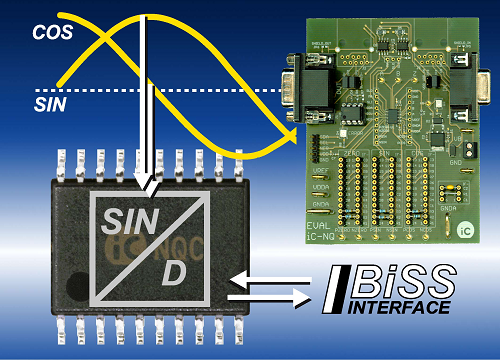
The cascadable demo board NQ6D for the evaluation of angle sensors and encoders comes with the advanced sine-to-digital converter iC-NQC. Here, the serial BiSS C interface permits clock-synchronized measurement reading from boards docked on to one another, useful for position sensing along several axes, for example. Sockets are provided for the insertion of optional components adapting the board for sine encoders with 1 V voltage or 11 µA current interfaces, or for incremental encoders with TTL signals.
We are familiar with serial data interfaces in industrial applications as point-to-point connectors, where, for example, absolute shaft encoders are connected up to the control unit via an SSI. In comparison, the BiSS interface not only offers a higher data rate and CRC checked transmission; it also permits a simple serial bus to be created by linking several slave ICs up in a chain. This function is supported by demo board NQ6D and specifically its two D-sub connectors placed opposite one another. Several boards can be docked on to one another. Thanks to the line drivers mounted on the board, it is also possible to have longer data cables leading to the host, PLC, or a BiSS PC adapter.
Devices iC-NQ, iC-NQi, and now iC-NQC have established themselves as industrial standards and provide very high interpolation resolutions of up to 13 bits (8,192 angle steps). They operate at a typical value of 70 MHz for raster-free A/D conversion and angle tracking practically in real time. Tracking rates of between 1.7 MSPS and 8 MSPS can be set. Board NQ6D separates digital and analog circuit components to prevent crosstalk and provides a wide range of possible connections to test various input circuitry, enabling the setup to be adapted to a number of different sine signals from shaft encoders, digital gauges, Hall, or MR angle sensors. It is also possible to evaluate incremental encoders with A/B and zero signals with TTL levels using the 24-bit period counter in the interpolator.
So that sensor errors can be rectified, iC-NQC has integrated conditioning circuits for the compensation of offset, amplitude, and phase errors. This considerably improves interpolation results and angle errors can be reduced to less than +/- 0.35 degrees.
During the cyclic data output with clock rates of up to 10 MHz, the new iC-NQC also permits simultaneous bidirectional register communication thanks to its BiSS C protocol. It is thus possible to access normed storage addresses for information such as device ID, serial number, OEM data areas, and EDS as an optional ID plate during the output of measurement values.
Various BiSS PC adapters are available for the operation of demo board NQ6D; a PC operating program can also be downloaded. Customer programming of sensor manufacturing equipment can be supported by a component DLL.
|
| Bu firma hakkında: |
iC-Haus GmbH is a leading independent German manufacturer of standard iCs (ASSP) and customized ASiC semiconductor solutions. The company has been active in the design, production, and sales of application-specific iCs for industrial, automotive, and medical technology for over 25 years and is represented worldwide. The iC-Haus cell libraries in CMOS, bipolar, and BCD technologies are fully equipped to realize the design of sensor, laser/opto, and actuator ASiCs, among others.
The iCs are assembled in standard plastic packages or using iC-Haus chip-on-board technology to manufacture complete microsystems, multichip modules, and optoBGA™, the latter in conjunction with sensors.
|
| Şirket Bilgileri: |
| Firma Adı: |
ic-Haus GmbH |
| adres: |
Am Kuemmerling 18, |
| şehir: |
Bodenheim |
| devlet/il: |
|
| ZIP: |
DE-55294 |
| ülke: |
Germany |
| Telefon numarası: |
+49-0-613592920 |
| Faks: |
+49-0 -61359292192 |
 |
 |
|